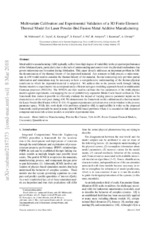Notice
This is not the latest version of this item. The latest version can be found at: https://oaktrust.library.tamu.edu/handle/1969.1/166278.2
Multivariate Calibration and Experimental Validation of a 3D Finite ElementThermal Model for Laser Powder-Bed Fusion Metal Additive Manufacturing
| dc.creator | Mahmoudi, Mohamad | |
| dc.creator | Tapia, Gustavo | |
| dc.creator | Karayagiz, Kubra | |
| dc.creator | Franco, Brian | |
| dc.creator | Ma, Ji | |
| dc.creator | Arróyave, Raymundo | |
| dc.creator | Karaman, Ibrahim | |
| dc.creator | Elwany, Alaa | |
| dc.date.accessioned | 2018-03-20T02:22:41Z | |
| dc.date.available | 2018-03-20T02:22:41Z | |
| dc.date.issued | 2018-03-19 | |
| dc.identifier.uri | https://hdl.handle.net/1969.1/166278 | |
| dc.description.abstract | Metal additive manufacturing (AM) typically suffers from high degree of variability in the properties/performanceof the fabricated parts, particularly due to the lack of understanding and control over the physical mechanisms thatgovern microstructure formation during fabrication. This paper directly addresses an important problem in AM:the determination of the thermal history of the deposited material. Any attempts to link process to microstruc-ture in AM would need to consider the thermal history of the material. In-situ monitoring only provides partialinformation and simulations may be necessary to have a comprehensive understanding of the thermo-physicalconditions to which the deposited material is subjected. We address this in the present work through linkingthermal models to experiments via a computationally efficient surrogate modeling approach based on multivariateGaussian processes (MVGPs). The MVGPs are then used to calibrate the free parameters of the multi-physicsmodels against experiments, sidestepping the use of prohibitively expensive Monte Carlo-based calibration. This framework thus makes it possible to efficiently evaluate the impact of varying process parameter inputs on the characteristics of the melt pool during AM. We demonstrate the framework on the calibration of a thermal model for Laser-Powder Bed Fusion AM of Ti-6Al-4V against experiments carried out over a wide window in the process parameter space. While this work deals with problems related to AM, its applicability is wider as the proposed framework could potentially be used in many other ICME-based problems where it is essential to link expensive computational materials science models to available experimental data. | en |
| dc.description.sponsorship | NASA’s Space Technology ResearchGrants Program, Grant No.NNX15AD71G. NSF-DGE-1545403, “NRT-DESE:Data-Enabled Discovery and Design of Energy Materials (D3EM).” NSF-CMMI-1534534 | en |
| dc.language.iso | en_US | |
| dc.rights | Attribution-NonCommercial-NoDerivs 3.0 United States | en |
| dc.rights.uri | http://creativecommons.org/licenses/by-nc-nd/3.0/us/ | |
| dc.subject | Metal Additive Manufacturing | en |
| dc.subject | Powder Bed Fusion | en |
| dc.subject | Finite Element Thermal Models | en |
| dc.subject | Uncertainty Quantification | en |
| dc.title | Multivariate Calibration and Experimental Validation of a 3D Finite ElementThermal Model for Laser Powder-Bed Fusion Metal Additive Manufacturing | en |
| dc.type | Preprint | en |
| local.department | Industrial and Systems Engineering | en |
| local.department | Materials Science and Engineering | en |



